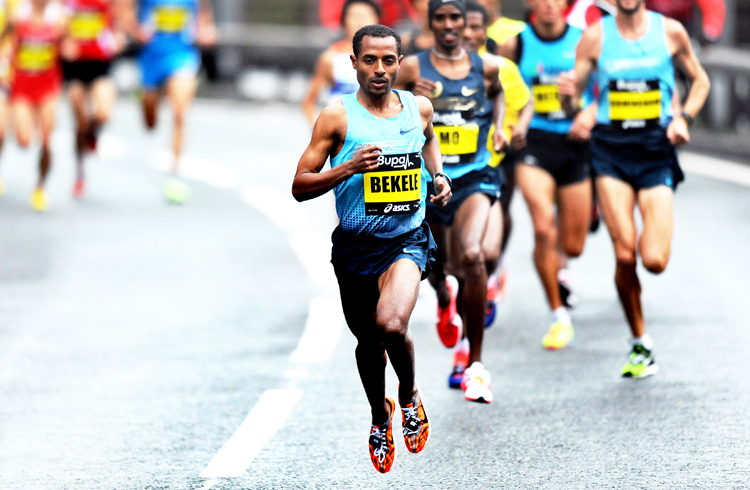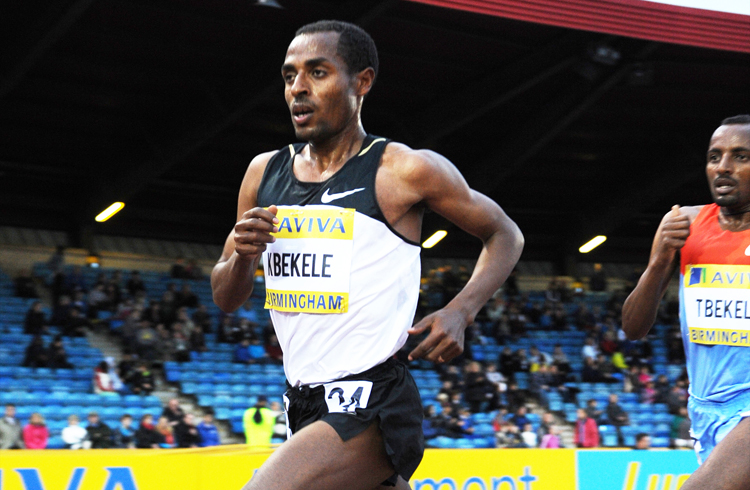
In flow: Bekele’s style is the embodiment of grace and power. Picture credit: Mark Shearman
Born in Bekoji, Ethiopia, the second of six children, Kenenisa Bekele began running in primary school. His initial inspiration came from watching other Ethiopian running greats, particularly Haile Gebrselassie. Following a stellar cross-country career, he turned his attentions to the track, focusing on the 5,000m and 10,000m. In 2004, he set the world record for 5,000m (12:37.35), with the 10,000m record (26:17.53) following a year later. Both records are still standing. In 2014, Bekele turned his attention to the marathon, winning in Paris in a time of 2:05:04. Injury had seemed to halt his progress over the 26.2-mile distance, although he was still able to finish third in this year’s London Marathon. Bekele, now 33, was left off the Ethiopian marathon team for this summer’s Olympics, but his stellar win at the Berlin Marathon this month confirms he’s right back on form.
Weight
Bekele weighs a mere 55kg. Gebrselassie is even lighter, at 54kg. Trying to cut weight is a dangerous precedent – and one that doesn’t always lead to improved performance – but there’s no doubt that cutting excess fat, while maintaining muscle, will lead to improved results. As a rule: focus on the quality of your calories rather than the quantity.
Inspiration
Bekele was inspired by the success of other Ethiopian distance greats, chiefly Haile Gebrselassie. The culture of running success, along with active outdoor lifestyles, is believed by many to be the key factor behind Ethiopia’s continual high performance in distance running.
Relaxation
Look at Bekele in full flow. He is a picture of calm intent: shoulders down, arms swinging, jaw relaxed. Even when moving at lightning-quick speeds, the Ethiopian exudes a grace and calm. By running in this way and focusing on reducing the tension though out his body, he wastes less energy and is able to run more efficiently.
Legs
Long legs and a short torso give Bekele the classic long-distance running build. He stands only 5ft 3ins but his stride length is almost 2 metres (6ft 5ins). Combine this with a quick cadence – around 180 steps per minutes – and you have electric speed.
Achilles
Bekele’s achilles heel is, er, his achilles heel. This tendon has caused him years of grief and led to a number of lengthy lay-offs. It’s perhaps due to his forefoot running style, which places more stress on the calf and achilles
Lungs
Like many stars of distance running, Bekele was born at altitude. His birthplace of Bekoji, a farming village, stands nearly 9,200ft above seal level and has produced 10 Olympic gold medals. Altitude training helps to increase the body’s number of oxygen-carrying red blood cells.
Related content: What makes mo so good?

On track: Bekele is master of the track, road and cross-country. Picture credit: Mark Shearman
Run like Bekele
Do cross-country
Bekele is the most accomplished cross-country runner in history, with six long (12 km) course and five short (4 km) course titles. Cross-country running is great for strength and stamina – and the UK is full of great events. Yes, it hurts, but the benefits are undeniable.
Run intervals
Part of Bekele’s success was based on his explosive kick. He’d often run the final lap of a 5,000m and 10,000m race in a tad over 50 seconds. To race fast, you have to train fast. And that means running intervals – short, intense periods of running followed by short rests, repeated several times. Have a go at 10 x 400m (or 10 x 80 seconds if you can’t find a track), with a minute recovery between sets.
Head to the hills
One of the benefits of Ethiopia from a training perspective is the hills. They’re everywhere. Many of Bekele’s runs would involve quick running up and down these slopes. Try to incorporate a hill session into your weekly routine to help improve form and build strength. Aim for 8 x 60 seconds, working hard on the uphill and recovering on the downhill.






